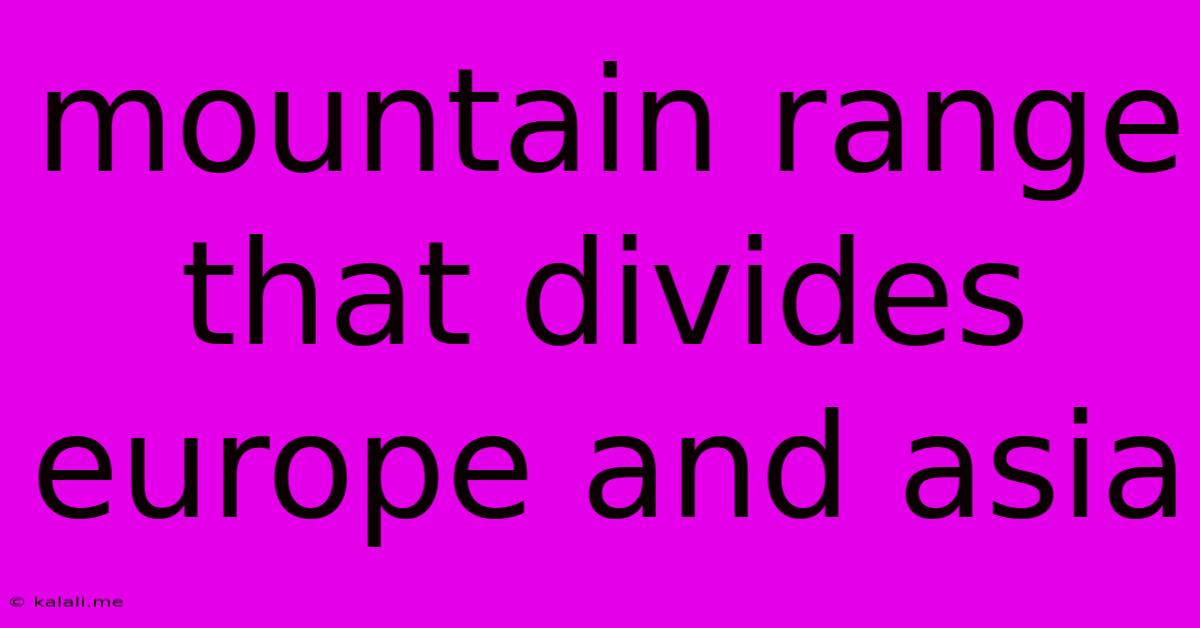Mountain Range That Divides Europe And Asia
Kalali
Jun 12, 2025 · 3 min read

Table of Contents
The Ural Mountains: Dividing Europe and Asia, A Natural Boundary in Question
The Ural Mountains, a vast and ancient mountain range stretching roughly 2,500 kilometers (1,550 miles) from the Arctic Ocean to the Ural River, are traditionally considered the geographical boundary between Europe and Asia. This demarcation, however, isn't as clear-cut as many believe, sparking ongoing debate among geographers and sparking interest in the unique geological and ecological features of this massive mountain chain. This article delves into the Ural Mountains, examining their role as a continental divider, their geological history, and the ongoing discussions surrounding their precise geographical significance.
Why the Urals are considered the Europe-Asia boundary: The Ural Mountains represent a significant geological shift, with distinct differences in terrain, flora, and fauna on either side. This visible physical barrier historically influenced human settlement patterns and provided a somewhat natural division between the two continents. Historically, this clear physical boundary helped define political and cultural boundaries, making it a convenient, albeit not universally accepted, line of demarcation. The consistent, linear nature of the range itself lends credence to its role in this geographical distinction.
Geological Formation and Characteristics: A Story Etched in Stone
The Ural Mountains are incredibly ancient, formed during the Paleozoic Era through a collision of tectonic plates. Their formation predates the separation of the supercontinent Pangaea, adding to their unique geological significance. The range boasts a diverse geological composition, including various types of rocks, minerals, and ores. This geological diversity has led to the region's significant mining history and abundance of natural resources, including valuable minerals like copper, nickel, and platinum. The Urals are not particularly tall by global standards, with their highest peak, Mount Narodnaya, reaching only 1,895 meters (6,217 feet). However, their sheer length and geological complexity contribute significantly to their environmental impact and historical significance.
Ecological Diversity: From Tundra to Forests
The Ural Mountains support a remarkable diversity of ecosystems, reflecting their vast latitudinal span. The northern stretches exhibit Arctic tundra, while progressing south, you find taiga (boreal forests) dominated by coniferous trees. Further south, the landscapes shift to mixed and deciduous forests before ultimately transitioning into steppe grasslands. This gradual change in ecosystems across the mountain range showcases a rich biodiversity, including many endemic species of plants and animals, some uniquely adapted to the Ural's unique habitats.
The Blurred Line: Debates about the Continental Divide
While the Ural Mountains are widely accepted as a boundary, the line isn't definitively drawn. Some geographers argue that the Ural River, the Emba River, the Kuma-Manych Depression, or even the Caucasus Mountains could offer more appropriate or comprehensive divisions. These alternatives consider factors beyond simple topography, taking into account geological formations, hydrological systems, and even biogeographical boundaries. The lack of a universally agreed-upon line highlights the complexities of defining continental boundaries. The debate underscores that geographical boundaries are often more fluid and complex than maps might initially suggest.
Cultural and Historical Significance: A Crossroads of Continents
Beyond their geographical importance, the Ural Mountains hold profound cultural and historical significance. They've been a crossroads for various cultures and civilizations for centuries, influencing the development of both European and Asian societies. The region boasts a rich history of mining, trade, and settlement, shaping its unique cultural landscape. Understanding the Ural Mountains requires appreciating their historical context, interwoven with the complex stories of the people who have lived there throughout history.
In conclusion, the Ural Mountains remain a powerful symbol, representing a significant geographical transition between Europe and Asia. Though the exact delineation of the continental boundary remains a subject of ongoing debate, the Urals' geological significance, ecological diversity, and rich history undeniably establish them as a pivotal feature of the Eurasian landmass. Their role as a cultural and historical crossroads adds layers of complexity to this vast and important mountain range, cementing its place in geographical study and broader human history.
Latest Posts
Latest Posts
-
The Chromosome Theory Of Inheritance States That
Jun 13, 2025
-
Inflation Implies That The Level Of All Prices
Jun 13, 2025
-
29 States Of India And Their Capitals
Jun 13, 2025
-
What Is Mmix In Roman Numerals
Jun 13, 2025
-
Which Is Not A Terrestrial Planet
Jun 13, 2025
Related Post
Thank you for visiting our website which covers about Mountain Range That Divides Europe And Asia . We hope the information provided has been useful to you. Feel free to contact us if you have any questions or need further assistance. See you next time and don't miss to bookmark.